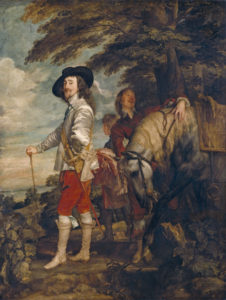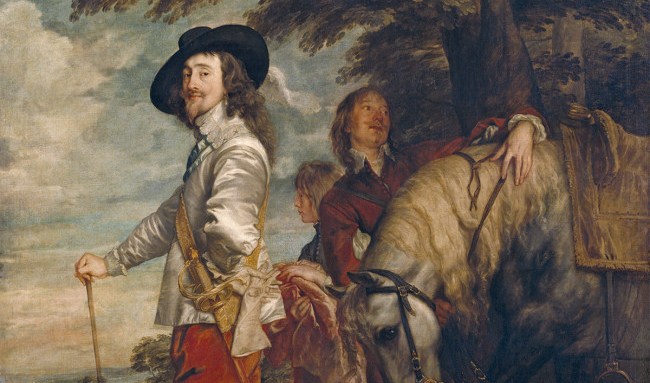01 March 2018
Charles I: King and Collector
At the Royal Academy (27 January – 15 April).
Reviewed by William Morton
A five star exhibition

Charles I was the second son of James I (and VI of Scotland). He became heir apparent on the death in 1612 of his popular older brother, Henry. One’s knowledge of him tends to be limited to the Civil War and his execution, but in fact he reigned from 1625 until 1649 and the Civil War broke out in 1642 so he had plenty of time to build up his art collection, although relations were always difficult between him and Parliament. He married Henrietta Maria, the daughter of Henri IV of France in 1625 and she is believed to have played a part in assembling it. It was given a kick-start by his acquisition in 1627 of the collection of the Gonzaga Dukes of Mantua. Following Charles’ execution, the Commonwealth auctioned off his collection and one fascinating aspect of the Exhibition is to see what prices were paid for some of the pictures – £800 for a Correggio (not Caravaggio) as against £11 for a Veronese. Following the auction, the paintings were widely dispersed, with some finding their way to the Prado including a fine Titian of the Spanish Emperor, Charles V with a dog, and others to the Louvre such as Van Dyck’s portrait, Charles I at the Hunt, both of which are in the Exhibition. On the Restoration, Charles II made efforts to recover the collection and many of the items on show are now owned by the Queen.
Van Dyck is, in some ways, the star of the show. He was appointed Court Painter in 1632 and died at the young age of 42 in 1641. There are some splendid examples of his work in the Exhibition. There is the well-known painting, Charles I in Three Positions; an appealing one of his wife with her dwarf servant and a pet monkey, Queen Henrietta Maria with Sir Jeffery Hudson; two large equestrian portraits of the King and one of the future Charles II ( looking rather sulky in a William Dobson picture nearby) and his siblings. There is the only mythological scene Van Dyck is known to have produced while at Court – Cupid and Psyche. All are lively and demonstrate his great technical skill. Charles is depicted as a fine and distinguished figure of a man, which was apparently not the case in real life – but then that is what a Court painter is for.
However, there is also an extraordinary range of work by other artists. There is an equestrian portrait by Rubens of George Villiers, the Duke of Buckingham, the favourite (lover?) of James I. Rubens, whose assistant Van Dyck was for a period, was employed by Charles (and knighted by him) to paint the ceiling of the Banqueting House outside which he was executed. There are some fine Titians including Supper at Emmaus and The Allocution of the Marquis de Vastoto his Troops. Mantegna is represented by his series, The Triumphs of Caesar; Orazio Gentileschi by pictures for The Queen’s House, Greenwich (perhaps a little dull); Holbein by striking portraits of London merchants and of Anne Cresacre, the ward of Sir Thomas More. Also in the Exhibition are Roman statues from the Gonzaga collection and Mortlake tapestries based on Raphael cartoons purchased by Charles.
The Exhibition is well displayed and one room is devoted to smaller eclectic items which were kept in Charles’ private apartments at Whitehall Palace, including miniatures by Nicholas Hilliard and Holbein (ones of Henry VIII and Jane Seymour, among others).
Charles’ interest in art and enjoyment of his collection is clear. Given its richness, it is amazing to think that what is shown in the Exhibition is only part of what he owned. Would he have fared any better if he had concentrated more on the day job?


